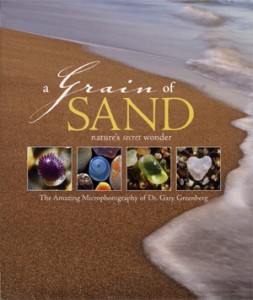“To see the world in a grain of sand…” is how William Blake begins his famous poem Auguries of Innocence. And it’s also how this book is introduced. Sometimes there’s limitless beauty in the smallest of things.
At the Hawaii Maritime Center there used to be an interactive display about the different kinds of sand found in the Hawaiian islands. You could see how scientists compare and collect the different types in order to define their compositions and characteristics. It’s interesting to learn how unique sand can be and that it’s just as diverse as Hawai’i’s people! Well, local author, scientist and artist Gary Greenberg took it one step further and compiled A Grain of Sand: Nature’s secret wonder (Voyageur Press, 2008) all about the various kinds of sand grains found on shores across the globe, from Greece to Hawaii.
 Dr. Gary Greenberg is from Haiku and is reknowned for his work with high-definition light microscopes. He turns science into art with his amazing microphotography that magnifies sand grains up to 300 times!!
Dr. Gary Greenberg is from Haiku and is reknowned for his work with high-definition light microscopes. He turns science into art with his amazing microphotography that magnifies sand grains up to 300 times!!
The publishers at Voyageur Press were kind enough to introduce me to this intriguing, and sadly overlooked, local author, by sending me a copy of his book. The nerd in me loves this eye catching way of exploring the biology, ecology and geology of different environments. Sand from the Sahara is vastly different from the sand in Hawai’i and so forth.
The photographs are surprising and beautiful, and so impossibly detailed that it’s just remarkable. Reading this book is like finding treasure. Greenberg’s microphotographs are nothing short of magical! He shows how the sands of various lands have different grain shapes and color; how they were formed; how each one has a personality and a story to tell. For example, Hawaiian sand grains contain multicolored minerals due to their volcanic origins and since there is abundant sea life here, the sand has bits of broken shells, coral and all manner of ocean life… the result is very colorful!
This is a great book for anyone interested in photography or geology but it’s a book everyone should experience at least once, if for nothing else than to admire the engineering genius found in such a small speck of earth. It really puts things into perspective so to speak. I hope to see more books from Dr. Greenberg and am excited to learn about the work he’s doing as both a local scientist and artist. Check out his webpage gallery of microphotos!




